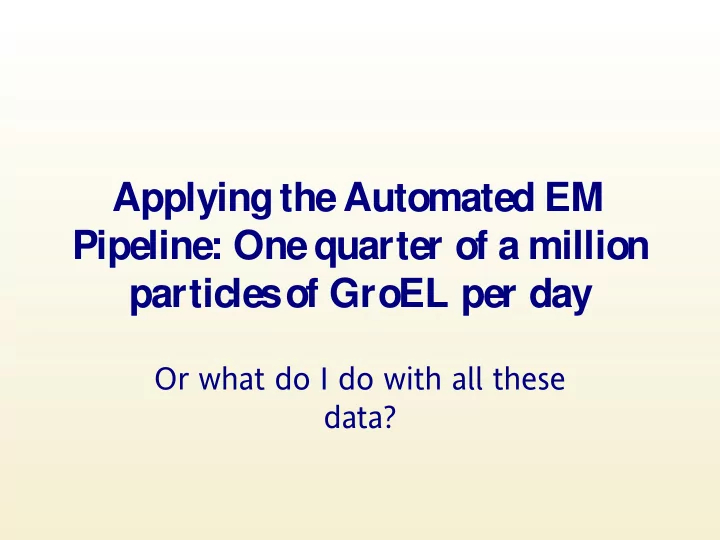

Applying the Automated EM Pipeline: One quarter of a million particles of GroEL per day Or what do I do with all these data?
Outline • What are the steps one takes to use automation in practice? • What are the obstacles one encounters along the way to a reconstruction?
Recons truction pipeline • Data Acquisition – Leginon • Particle picking – Selexon • CTF estimation – ACE • Selecting “good” data – Database queries – ??? • Reconstruction
Background • GroEL has been our driver for developing both automated data collection and automated data analysis • 150,000 particles/24 hours a year ago • Over the last year, led to the development of – Environment monitoring – Database reports – Training data for ACE – Optimize protocols for single particle reconstruction with EMAN and Frealign – Creation of JAHCs grids
Data Acquis ition
Automated data acquis ition with Leginon Multis cale Imaging Automated micros cope control Suloway et al. (2005) J. Struct. Biol., In press.
How long does it take? • Setup – 1 h on a good day - 5 h on a bad day • Stability of microscope/problems with specimen • Acquisition – Creating the atlas • 15 min – Finding holes • ~30s for square image • < 1s for hole image – Focusing • 10s for algorithm + 5-30s for melting ice – Reading and correcting the high-resolution exposures • ~30s / exposure
Image collection s tatis tics • Defocus pairs: 552 – 50,000X, 2.263 Å/pix, -0.8 to -2.0 µ m defocus – Hundreds of particles per image • Focus images: 273 – 50,000X • Holes visited: 318 – 5000X, 179 Å/pix, -150 µ m defocus • Squares visited: 32 – 800X, 558 Å/pix, -2mm defocus • Total time: 25h
Picking particles
Automated particle picking Selexon ~95% accurate 280,000 particles picked Roseman (2004) JSB, 145 Zhu et al. (2004) IEEE ISBI04 conference
How long does it take? • Setup – Creating templates • 1-2 hours – Setting parameters • 30 min • Automated particle picking – ~2 min/micrograph
CTF Es timation
Automated CTF es timation ACE Mallick et al. (2005) Ultramicroscopy,104
ACEMAN • Reads Imagic stacks instead of entire micrographs • Uses EMAN formulation for noise and envelope • So far does not include structure factors – Structure factors should be implemented w/i a month
ACEMAN
How long does it take? • Setup – 1 minute • Automated CTF estimation – ~1 minute/micrograph – Slightly faster with ACEMAN
Databas e reports http://cronus3.scripps.edu/dbem/summary.php?expId=1933
The bottom line: How do thes e parameters affect the recons truction? • Can we sort the data in such a way that we focus only on “good” particles? – Sort by ice thickness – Sort by ACE data – Sort by drift – Sort by temperature – ???
Sorting particles by ice thicknes s • Sorting scheme – Throw away any micrograph with ACE confidence value < 0.8 (manually verified that all fits > 0.8 are correct) – Take defocus measurements from ACE and sort micrographs into small (0.5-1.0), medium (1.0-1.5), and large (1.5-3.0) defocus sets – Sort defocus sets and split into 10 subsets by increasing ice thickness – Find set with least ptcls and randomly remove ptcls from other sets until all have same # ptcls (~15,800) • Result is 10 sets of particles with equivalent range of defoci • Reconstruct each set using EMAN
Res olution decreas es with increas ing ice thicknes s Resolution vs. Ice thickness 10.2 y = 5.9957x + 8.8168 10.1 10 9.9 9.8 9.7 9.6 9.5 9.4 9.3 9.2 0.1 0.12 0.14 0.16 0.18 0.2 0.22 Ice thickness (K* ln I/I0)
FSC of highes t res olution s tructure Resolution = 9.3Å
The s tructure of GroEL Thinnest ice structure Amplitude corrected via Spider
Sorting particles by ice thicknes s - amp. corrected • Sorting scheme – Use ACEMAN to estimate noise and envelope, but use original ACE estimation for defocus – Throw away any micrograph with ACE confidence value < 0.8 – Take defocus measurements from ACE and sort micrographs into small (0.5-1.0), medium (1.0-1.5), and large (1.5-3.0) defocus sets – Sort defocus sets and split into 10 subsets by increasing ice thickness – Find set with least ptcls and randomly remove ptcls from other sets until all have same # ptcls (~15,800) • Result is 10 sets of particles with equivalent range of defoci • Reconstruct each set using EMAN – Apply envelope correction to class averages towards the end of the refinement
FSC of thinnes t ice Resolution = 6.5Å Nyquist = 4.526Å
GroEL at 6.5Å?
Can we get even higher res olution? • Refine with all 280,000 ptcls • Average volumes from multiple reconstructions • What do we do about amplitudes? • What is the resolution?!!!
Average of all volumes Volume was amplitude corrected via Spider
Average of all volumes QuickTime™ and a H.264 decompressor are needed to see this picture.
What is the res olution? Resolution (FSC 0.5 ) = 10.2Å
Comparis on with 6.5Å Amplitude corrected Average of 10 during refinement volumes 6.5Å? 10.2Å?
The pipeline in action
Acknowledgments • Leginon – Denis Fellman – Jim Pulokas – Christian Suloway – Joel Quispe – Anchi Cheng • ACE – Satya Mallick • Selexon – Yuanxin Zhu – Alan Roseman
Recommend
More recommend